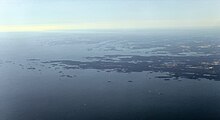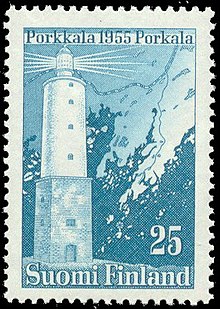Porkkala lease area
Coordinates: 59 ° 59 ' N , 24 ° 26' E
The lease area Porkkala ( also Porkala in German and Swedish spelling ) was a military base about 30 kilometers west of Helsinki , the area of which Finland had to lease to the Soviet Union for 50 years as a condition of the Moscow armistice in 1944 , but was given back prematurely in 1956.
Geographical location
The leased area consisted of the Porkkala peninsula , its hinterland and an area to the west of it. The tip of the peninsula is only 36 km from the coast of Estonia on the other side of the Baltic Sea . She thus had an important position for controlling the sea-side access to Leningrad ; because artillery positions on both sides could block this access.
Lease area
At the end of the Second World War , Porkkala was leased as a military base from Finland to the Soviet Union in place of the Hanko peninsula, which was abandoned during the war, due to its military strategic position in the armistice of Moscow (1944) . This happened for a period of 50 years (from 1944 to 1994). The Soviet Union was granted the right to use the peninsula as a naval base . This meant that the area became extraterritorial for Finland , so it was no longer subject to Finnish, but to Soviet government . The then Finnish President, Carl Gustaf Emil Mannerheim , viewed this as a military occupation of Finland. The Soviet coastal artillery in Porkkala could easily have bombarded Helsinki because of its range.
In addition to the peninsula, the lease area also included adjacent areas and was 380.5 square kilometers in size (with a sea area of around 1000 km²). It included the municipalities of Kirkkonummi and Ingå , the then still independent municipalities of Porkkala and Degerby and parts of the municipality of Siuntio . The total of approximately 8,300 residents of the area were given ten days to evacuate. The Red Army took over the area without ever setting up a civil administration there. First in command was Lieutenant General Sergei Ivanovich Kabanow (1901–1973), who had previously commanded the Hanko lease area . The lease was confirmed in the Peace of Paris in 1947 . In addition to the coastal artillery here air defense artillery, one was Panzer - Regiment , a division of the Red Army, three regiments of Marines and supply units stationed - a total of about 30,000 soldiers . There were also about 10,000 civilians, including family members. The facility received a command bunker, which was designed against an attack with hydrogen bombs . Porkkala was also a center of Soviet foreign espionage .
Due to a changed political situation, the Soviet Union and Finland signed a treaty on September 19, 1955, exactly eleven years after the armistice, and the Soviet Union renounced the lease area on January 26, 1956, which fell back to Finland. The reasons for this were a number of political and technical factors: the concept of neutrality pursued by Finland , which also ruled out the country's accession to NATO , the abandonment of Stalinism by the Soviet Union under Nikita Sergeyevich Khrushchev and the greater possible range of the coastal artillery, some Made posts on the northern side of the Gulf of Finland redundant. The former residents got their property back.
Consequences for rail traffic
Upon handover, the Soviet Union took over the almost 40 km long section of the Helsinki – Turku railway line , a main line in the Finnish railway network, with the Kirkkonummi station . The Kauklahti station to the east and the Tähtelä station to the west, however, remained in areas that were still subject to Finnish sovereignty .
1944-1947
The railway line was used exclusively for transit trains from the Soviet Union to the leased area of Porkkala. The route was completely closed to Finnish rail traffic. All Finnish inland rail traffic between Helsinki and Turku had to take the detour via Toijala .
1947-1956
The lease of Porkkala was confirmed in the Peace of Paris in 1947 . This gave the Soviet Union greater certainty about the future status of the area and was ready for its part to compromise on practical issues with Finland. In 1947, for example, there was an agreement on transit traffic for trains operated by the Finnish State Railways . Only passenger trains were allowed to transit, freight trains still had to take the detour. Only Finnish passenger and baggage cars were transported here. At the two "border stations" Kirkkonummi and Kauklahti, not only was there a change of locomotive between Finnish and Soviet locomotives, all windows of the train had to be screwed with screens to prevent photography . This measure earned the transit the designation “Finland's longest tunnel” . In addition, the doors were locked. This operation began in November 1947 and ended on January 26, 1956 when the Soviet Union prematurely returned the lease area to Finland.
literature
- Mikko Alameri: Railways in Finland = International Archive for Locomotive History 22. Vienna 1979, ISBN 3-900134-22-7 , p. 30f.
- Pekka Silvast: Porkkala 1944–56 . In: Neuvostoliiton merisotilaallinen tukikohta. Sotamuseon tutkimusraportti (1/1991). Hanko 1991.
Web links
- Welcome to the Porkkala Parenthesis. Porkkalan Parenteesi 2016, accessed on January 27, 2016 .
Individual evidence
- ↑ Alameri, p. 31
- ^ A b Riitta Vainio: Parliament within range of Soviet guns. Sixty years ago. Helsingin Sanomat , September 29, 2004, archived from the original on February 23, 2006 ; accessed on January 26, 2016 (English).




